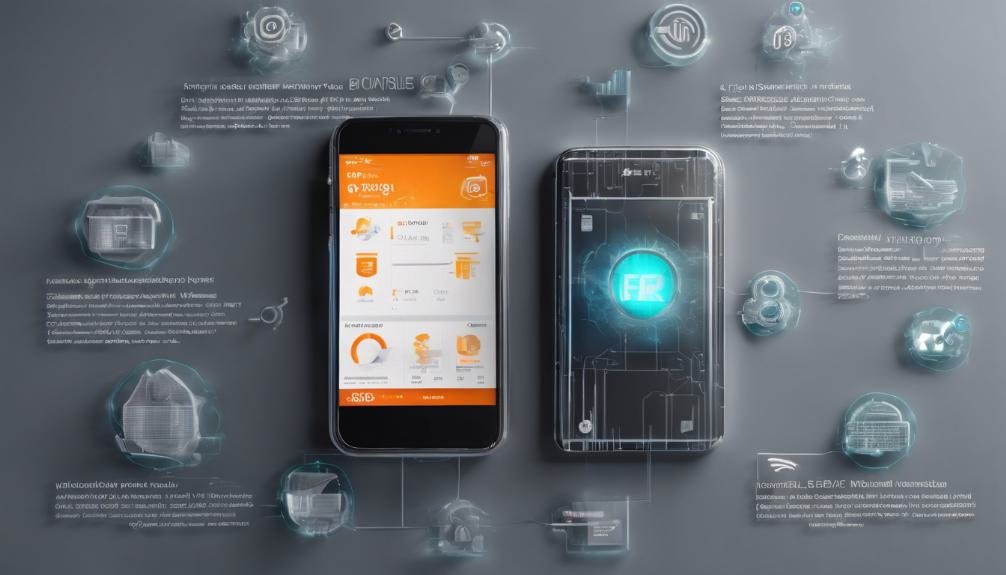The Evolution of Mobile Banking: What’s Next?
Imagine mobile banking as a river constantly flowing, adapting, and shaping its course over time. Just as the river navigates through varying landscapes, mobile banking has evolved through technological landscapes, shaping new ways for you to manage your finances. But what lies beyond the bend? The future of mobile banking holds promises of AI-driven insights, predictive analytics, and heightened security measures. Stay tuned to explore how these advancements will reshape your digital banking experience.
Key Takeaways
- Enhanced biometric security measures for heightened protection.
- AI-driven personalization for tailored financial experiences.
- Integration of blockchain technology for enhanced security and transparency.
- Expansion of contactless payment options for convenience.
- Continued focus on regulatory compliance and data privacy.
Historical Origins of Mobile Banking
How did the concept of mobile banking first emerge, and what were the key factors influencing its historical origins?
The early development of mobile banking can be traced back to the late 1990s when the first basic services were introduced in the form of SMS alerts and notifications. These rudimentary features laid the foundation for what would later become a pivotal way of managing finances on-the-go.
Technological advancements played a significant role in shaping the evolution of mobile banking, with the introduction of smartphones and mobile applications transforming the industry.
The convergence of mobile technology and banking services opened up a world of possibilities, allowing customers to access their accounts, make transactions, and receive real-time updates conveniently.
The shift towards digitalization and the increasing reliance on mobile devices further propelled the growth of mobile banking. As more banks embraced this trend and invested in user-friendly interfaces, the popularity of mobile banking soared.
The early days of mobile banking may have been humble, but they set the stage for a transformation that continues to redefine the way we interact with financial services.
Advancements in Mobile Payment Technology
The evolution of mobile payment technology has revolutionized the way individuals conduct financial transactions on a daily basis. Mobile payment innovations have paved the way for more convenient and secure transactions, with contactless transactions becoming increasingly popular due to their speed and ease of use.
| Advancements | Benefits | Impact |
|---|---|---|
| Mobile wallets | Convenience of storing multiple cards securely | Reducing the need to carry physical cards |
| NFC technology | Secure and fast contactless payments | Speeding up transactions and enhancing security |
| QR code payments | Easy payment method using smartphones | Widening the accessibility of mobile payments |
These advancements have not only streamlined the payment process but have also increased the adoption of mobile payment solutions globally. As more businesses embrace contactless transactions, the future of mobile payments looks promising, offering users a seamless and efficient way to manage their finances.
Rise of Biometric Authentication
With the increasing demand for enhanced security measures, the rise of biometric authentication in mobile banking has greatly transformed the landscape of digital financial transactions. Biometric authentication methods such as facial recognition and voice authentication have gained popularity due to their ability to provide a significant and essential way for users to access their accounts.
Facial recognition technology analyzes unique facial features to verify a user's identity, offering a high level of security by making it nearly impossible for unauthorized users to access an account. Voice authentication, on the other hand, uses the unique characteristics of an individual's voice to grant access, adding an extra layer of protection against fraudsters.
The adoption of biometric authentication in mobile banking not only enhances security but also improves the user experience by eliminating the need to remember complex passwords or PINs.
As technology continues to advance, biometric authentication is expected to play an important role in shaping the future of mobile banking, providing users with a seamless and secure way to manage their finances.
Integration of AI and Machine Learning
In the domain of mobile banking, the integration of AI and machine learning has revolutionized the way financial institutions interact with users and manage transactions. AI integration in mobile banking allows for personalized user experiences, predictive analytics, and real-time decision-making processes.
Machine learning advancements have enabled financial institutions to enhance fraud detection mechanisms, optimize customer service through chatbots, and streamline back-end processes for faster transaction processing.
By leveraging AI integration, mobile banking apps can analyze user behavior patterns to offer tailored financial recommendations and detect potentially fraudulent activities proactively. Machine learning algorithms continually learn from data inputs, enabling them to adapt and improve accuracy over time.
This not only enhances the overall user experience but also increases operational efficiency and reduces risks associated with financial transactions.
As financial institutions continue to harness the power of AI and machine learning in mobile banking, we can expect to see further advancements in automation, personalized services, and data-driven decision-making processes. These technologies are poised to shape the future landscape of mobile banking, providing users with more secure, efficient, and convenient financial services.
Enhanced Cybersecurity Measures
Amidst the evolving landscape of mobile banking, implementing enhanced cybersecurity measures is vital to safeguarding sensitive financial data and ensuring secure transactions. Biometric authentication stands out as a robust method for verifying user identities, offering a higher level of security compared to traditional password-based systems. By utilizing biometric markers like fingerprints or facial recognition, mobile banking apps can greatly reduce the risk of unauthorized access.
Moreover, fraud prevention mechanisms play an essential role in maintaining the integrity of mobile banking platforms. Advanced algorithms can analyze transaction patterns in real-time, flagging any suspicious activities and preventing fraudulent transactions before they occur. These proactive measures not only protect consumers from financial losses but also enhance their trust in the security of mobile banking services.
Personalization and Customization Trends
To adapt to the evolving landscape of mobile banking, exploring the latest personalization and customization trends is imperative for enhancing user experiences and driving customer engagement. Customized experiences tailored to user preferences are becoming increasingly crucial in the competitive mobile banking market. Leveraging data analytics to understand user behavior and preferences allows financial institutions to offer personalized services that cater to individual needs effectively.
| Personalization and Customization Trends | Benefits |
|---|---|
| Customized Experiences | Enhances user engagement |
| Data Analytics | Provides insights for tailored services |
| Personalized Services | Increases customer satisfaction |
| User Preferences | Drives loyalty and retention |
| Seamless Integration | Improves overall user experience |
Expansion Into Emerging Markets
As mobile banking services expand into emerging markets, market penetration strategies play a vital role in reaching untapped customer bases.
Technology adaptation challenges arise due to varying levels of digital infrastructure and connectivity in these regions, necessitating innovative solutions for seamless mobile banking experiences.
Regulatory compliance considerations become paramount when operating in diverse regulatory environments, requiring a nuanced approach to guarantee legal adherence while driving growth.
Market Penetration Strategies
With the increasing saturation of mature markets, the evolution of mobile banking necessitates a strategic focus on expanding into emerging markets to sustain growth and capitalize on untapped opportunities.
To penetrate these markets effectively, financial institutions need to employ targeted marketing strategies that resonate with the local demographics. By understanding the unique needs and preferences of customers in emerging economies, banks can tailor their services to enhance customer engagement and loyalty.
Brand positioning plays a pivotal role in gaining traction in new markets. Establishing a strong brand presence that aligns with the values and aspirations of the target demographic can help differentiate a bank from competitors and build trust among customers.
Demographic targeting is essential for directing resources towards segments with the highest growth potential, ensuring that marketing efforts yield the best results.
Technology Adaptation Challenges
Successfully managing the technological adaptation challenges when expanding into emerging markets requires a deep understanding of local infrastructure and consumer behavior. In these markets, user experience plays an essential role in the adoption of mobile banking services. Ensuring that the app is intuitive, easy to navigate, and optimized for low connectivity scenarios can greatly impact user engagement and retention rates.
Additionally, addressing data privacy concerns is paramount to building trust with consumers. Implementing robust security measures, transparent data handling practices, and compliance with local regulations are essential for safeguarding sensitive information.
When entering emerging markets, it's important to tailor the mobile banking experience to meet the unique needs and preferences of the local population. Conducting thorough market research and user testing can provide valuable insights into consumer behavior, allowing for the development of tailored solutions that enhance user experience while prioritizing data privacy.
Regulatory Compliance Considerations
Managing regulatory compliance considerations when expanding into emerging markets is essential for mobile banking providers looking to establish a sustainable presence and build trust with consumers. In these markets, compliance risks can vary greatly from those in more developed regions, necessitating a nuanced approach to regulatory updates.
Here are three key factors to keep in mind:
- Local Regulations: Understanding and adhering to the specific regulations of each emerging market is paramount. This involves staying up-to-date with regulatory changes, licensing requirements, and consumer protection laws to guarantee compliance at all times.
- Data Privacy Laws: Data protection regulations can differ widely across countries. Implementing robust data privacy measures, such as encryption protocols and secure storage practices, is essential for safeguarding customer information and complying with local laws.
- Anti-Money Laundering (AML) Compliance: Emerging markets may have distinct AML regulations that mobile banking providers must adhere to in order to prevent financial crimes. Developing stringent AML policies and conducting regular audits can help mitigate compliance risks and protect against potential regulatory penalties.
The Future of Mobile Banking Innovations
You can expect the future of mobile banking to be shaped by cutting-edge innovations.
Enhanced biometric security measures will offer a more secure and convenient way for you to access your accounts.
Ai-powered personalization features and seamless cross-platform integration will further enhance your banking experience, making transactions smoother and tailored to your preferences.
Enhanced Biometric Security
The implementation of enhanced biometric security measures represents a pivotal advancement in the field of mobile banking innovations, setting the stage for a more secure and seamless user experience. Biometric authentication methods like voice recognition and fingerprint scanning offer unparalleled security benefits while enhancing user convenience.
Here's how these technologies are shaping the future of mobile banking:
- Increased Security: Biometric authentication provides a higher level of security compared to traditional methods like passwords or PINs. Voice recognition and fingerprint scanning offer unique identifiers that are difficult to replicate, minimizing the risk of unauthorized access.
- Enhanced User Experience: By incorporating biometric security measures, mobile banking apps offer a more streamlined and user-friendly experience. Users can quickly and securely access their accounts without the hassle of remembering complex passwords.
- Future-Proof Technology: Biometric authentication is continuously evolving to provide even more robust security features, ensuring that mobile banking remains at the forefront of technological advancements in the financial industry.
Ai-Powered Personalization Features
With the integration of AI-powered personalization features, mobile banking is poised to revolutionize the way users interact with their financial accounts, offering tailored insights and customized experiences. AI-powered recommendations will play a pivotal role in enhancing user experience optimization, providing customers with personalized suggestions based on their spending habits, savings goals, and financial behavior. By analyzing vast amounts of data in real-time, artificial intelligence algorithms can proactively recommend suitable financial products, budgeting tips, and investment opportunities tailored to each individual's unique needs.
| AI-Powered Personalization Features |
|---|
| 1. Personalized Spending Insights |
| 2. Customized Savings Recommendations |
| 3. Tailored Investment Suggestions |
These AI-driven capabilities will not only streamline banking processes but also foster a deeper level of engagement and trust between users and their financial institutions. As mobile banking continues to evolve, the power of AI in delivering personalized financial solutions will unquestionably shape the future landscape of digital banking experiences.
Seamless Cross-Platform Integration
Seamless cross-platform integration represents the next frontier in mobile banking innovations, promising enhanced connectivity and convenience for users across multiple devices. This advancement guarantees enhanced connectivity and convenience for users across smartphones, tablets, and desktops without any disruption in their banking experience.
Here's how this innovation is shaping the future of mobile banking:
- Platform compatibility: Banks are increasingly focused on ensuring that their mobile banking apps are compatible with various operating systems, such as iOS, Android, and Windows, to cater to a wide range of users.
- Data synchronization: With seamless cross-platform integration, users can expect real-time synchronization of their banking data across all devices, providing them with up-to-date information regardless of the device they're using.
- Security protocols: To maintain the integrity of user data, stringent security measures are being implemented to safeguard information as it moves between different platforms, ensuring a secure and trustworthy mobile banking experience.
Conclusion
As you navigate the ever-evolving landscape of mobile banking, remember that the future holds a treasure trove of innovations waiting to be discovered.
Like a compass guiding you through uncharted waters, advancements in AI, biometric authentication, and personalized services will lead you to a world of convenience and security.
Embrace the journey ahead with open arms, for the possibilities are as vast and exciting as the endless horizon.








